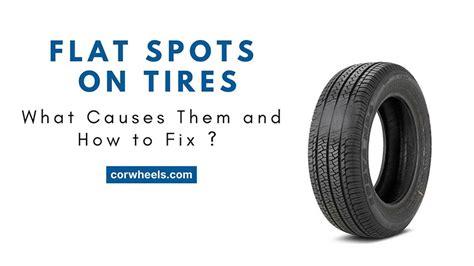Flat Spot Woes? Your Tire Fix is Here!
Dealing with a flat spot on your tire? That annoying wobble and unsettling thump-thump-thump sound can be incredibly frustrating. But don't despair! This comprehensive guide will walk you through understanding the causes of flat spots, assessing the damage, and exploring the best solutions to get your tires back in top shape.
What Causes Flat Spots on Tires?
Flat spots, those unsightly and uncomfortable deformations on your tire's tread, are typically caused by prolonged periods of stationary weight on the tire. This prolonged pressure deforms the tire's internal structure, leaving a flattened area. Several factors contribute to this:
-
Prolonged Parking: Leaving your vehicle parked in one spot for an extended period, especially on a hard surface, is a major culprit. The weight of the vehicle slowly compresses the tire at the contact patch. This is particularly common with heavier vehicles or when parked on uneven surfaces.
-
Improper Storage: Incorrectly storing tires, whether mounted on rims or not, can lead to flat spots. Tires should be stored upright and rotated regularly to prevent prolonged pressure on any one area.
-
Brake Issues: In some cases, consistently engaging the parking brake too tightly can put undue pressure on the tires, contributing to flat spots. While less common, this is definitely something to consider.
-
Low Tire Pressure: Running your tires consistently at low pressure can also exaggerate the effect of prolonged weight, increasing the likelihood of flat spot formation.
How to Assess the Severity of a Flat Spot
Before deciding on a course of action, you need to assess the severity of the flat spot. A minor flat spot might resolve itself with normal driving, while a more significant deformation might require professional intervention.
-
Visual Inspection: Carefully examine the tire for the flat spot. Is it a small, barely noticeable imperfection, or a large, deeply indented area?
-
Feel the Tire: Run your hand along the tire's tread. Can you feel a significant difference in the tire's profile where the flat spot is located?
-
Drive Test (Low Speeds): Perform a low-speed test drive. Do you notice a noticeable thumping or vibration? A slight thump might resolve itself, but a pronounced vibration usually indicates a more significant issue.
Can You Fix a Flat Spot Yourself?
Unfortunately, there's no DIY "flat spot repair kit." You can't simply patch or fill a flat spot like a puncture. The damage is internal to the tire's structure. However, minor flat spots often correct themselves.
Driving it Out: For minor flat spots, often driving at moderate speeds for a period can sometimes alleviate the issue. The heat generated by the tire flexing helps to reshape the rubber. This is a low-cost solution worth trying first.
Professional Intervention: More significant flat spots often won't correct themselves. In these cases, you'll likely need to consult a tire professional. They may suggest:
-
Tire Rotation: Rotating your tires can distribute the wear and tear more evenly, preventing further deformation.
-
Tire Replacement: In severe cases, the only solution is to replace the affected tire. This is particularly true if the flat spot is causing significant vibration or imbalance.
How to Prevent Flat Spots in the First Place
Preventing flat spots is easier than fixing them. Follow these steps to protect your tires:
-
Regular Rotation: Rotate your tires every 5,000-8,000 miles (or according to your vehicle's manual).
-
Proper Tire Pressure: Maintain the recommended tire pressure for your vehicle. Check your pressure regularly and adjust as needed.
-
Avoid Prolonged Parking: Whenever possible, avoid leaving your vehicle parked in one spot for extended periods. If this is unavoidable, consider using tire ramps to relieve pressure on the tires.
-
Correct Parking Brake Usage: Avoid excessively tightening the parking brake.
-
Proper Storage: Store tires properly when not in use. Keep them upright and rotate them regularly.
Will a Flat Spot Affect My Vehicle's Handling?
Yes, a flat spot can impact your vehicle's handling. The uneven tire surface can cause vibrations, reduced traction, and an unsettling feeling while driving. In severe cases, it can even lead to instability or reduced control.
Frequently Asked Questions
How long does it take for a flat spot to go away?
The time it takes for a flat spot to disappear depends on the severity of the deformation and driving conditions. Minor flat spots might correct themselves within a few miles, while more significant ones may take considerably longer or never fully disappear.
Can you drive on a tire with a flat spot?
Yes, you can usually drive on a tire with a flat spot, but it's not ideal. The flat spot will cause vibrations and may affect handling. It's best to assess the severity and address it if it's causing significant issues.
How much does it cost to replace a tire with a flat spot?
The cost of replacing a tire varies depending on the type of tire, the location, and the retailer. It's best to get quotes from several tire shops.
This guide provides a comprehensive overview of dealing with flat spots on your tires. Remember, prevention is key! By following these simple tips, you can significantly reduce the likelihood of encountering this frustrating issue.

